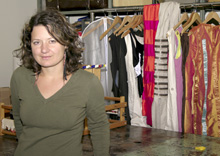Wireless and wearable, the shirt that remembers

Joanna Berzowska
Photo by Kendra Ballingall
Soft, silky and squishy are not words we typically use to describe computers. Joanna Berzowska, an assistant professor in Digital and Computation Arts, is changing that by creating digital media that look like clothing and feel like textiles.
Berzowska is a central figure in the field of soft computation. Through the Hexagram Research Institute and the XS Design Studio, both affiliated with Concordia, she is developing the latest prototypes in electronic textiles, reactive materials, and squishy interfaces.
Some of her latest and most intriguing works are computers we can wear. Wearable computers have been around for decades, and not only in science fiction.
Some, like digital watches, are now mass produced and ubiquitous. Others failed to make it beyond the haute-couture runways or the research labs, and Berzowska has an idea why.
Adding to her two undergraduate degrees in pure mathematics and fine arts, Berzowska completed her MSc at MIT along with some of the other innovators in the field. Steve Mann, the first self-described cyborg, was among others designing heavy plastic or metal emissive devices, components that are usually put in a pocket or attached to a jacket using Velcro.
These wearable computers “look just like a little computer, like a circuit board that’s hard and square and uncomfortable,” Berzowska explains. For these designers, “it’s about being superhuman, with extra vision, extra strength, and connectivity. It’s very much about the machine, and it’s disembodied.”
Berzowska feels wearable computers should be soft. The visual and tactile qualities of textiles inform her work.
“We’re trying to replace wires with conductive thread, for example, that can be embroidered or woven or sewn,” she says. “Instead of soldering something on, maybe we’ll stitch it, to really come closer to what textiles are. We don’t forget about the body.”
Berzowska integrates thermochromic pigments, control electronics, and conductive or resistant threads such as silver or stainless steel into fabrics like linen or silk. The results are textiles that change colour, pattern, or texture, light up, or display low-resolution animations. The visuals depend on the programming of the electronics, the warp and weft of the thread, and input such as heat, sound, and physical contact.
Indeed, some of the prototypes are designed to sense and react to their environments. Berzowska’s “intimacy” shirt and skirt are part of the Memory Rich Garment Project, which examines the differences between human and computer memory, and asks what it might mean for an object to remember.
Microphone
Incorporated in the collar of the intimacy shirt, a microphone detects the slightest whisper from a friend, partner, or otherwise. Lights stitched along the side of the shirt illuminate according to the intensity of the breath, and touch sensors in the skirt trigger gradual colour changes. The garments reveal intimate moments as they happen.
While most of the funding in her field goes to the development of military and surveillance technologies, Berzowska is exploring the potential of electronic textiles for self-expression and critical thought. The intimacy suit is playful and aesthetically interesting, but it is also a critique on the limits and problems of technology.
“The point of the intimacy suit is to get people to reflect on how technologies that we wear on our bodies are redefining what’s public and what’s private.”